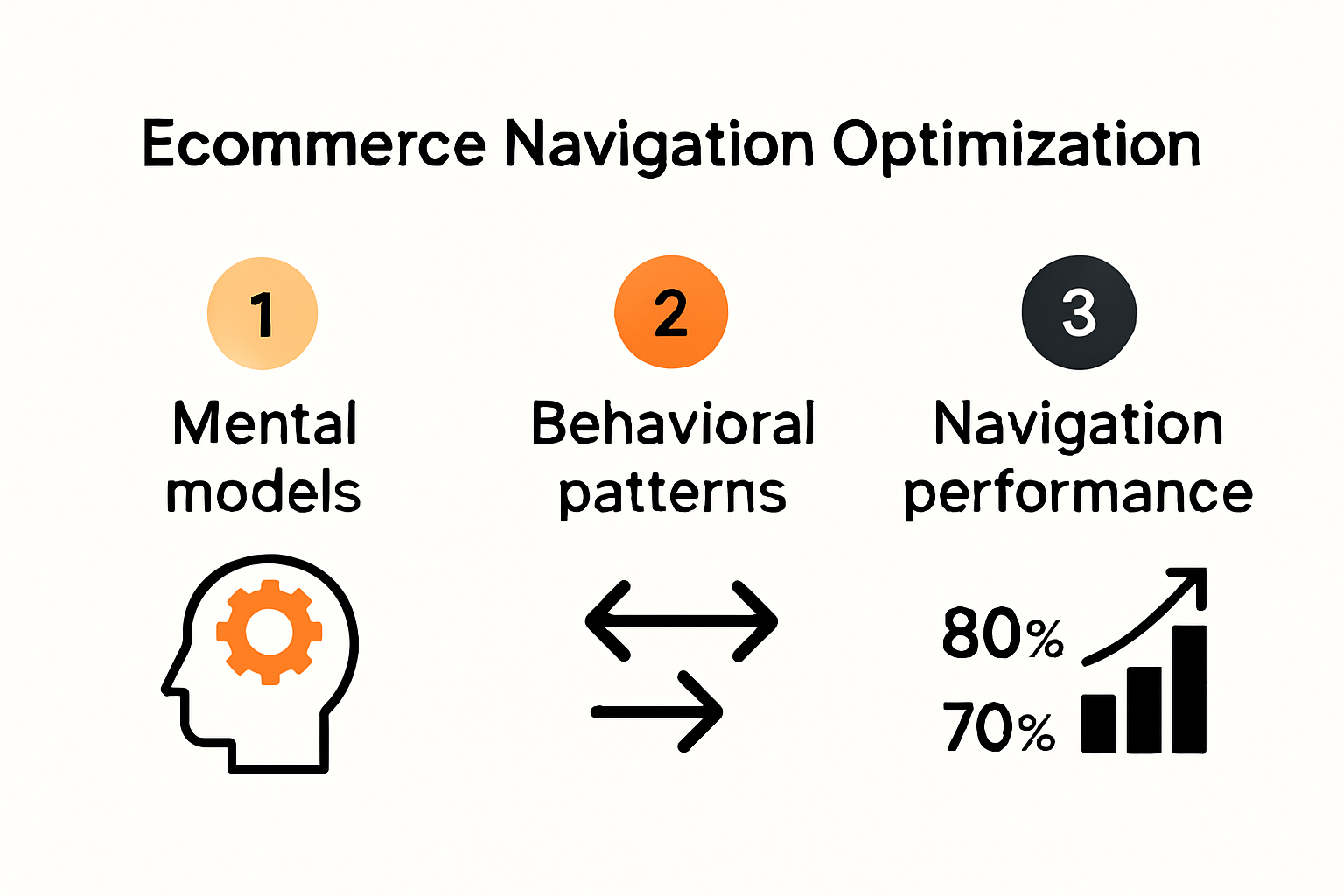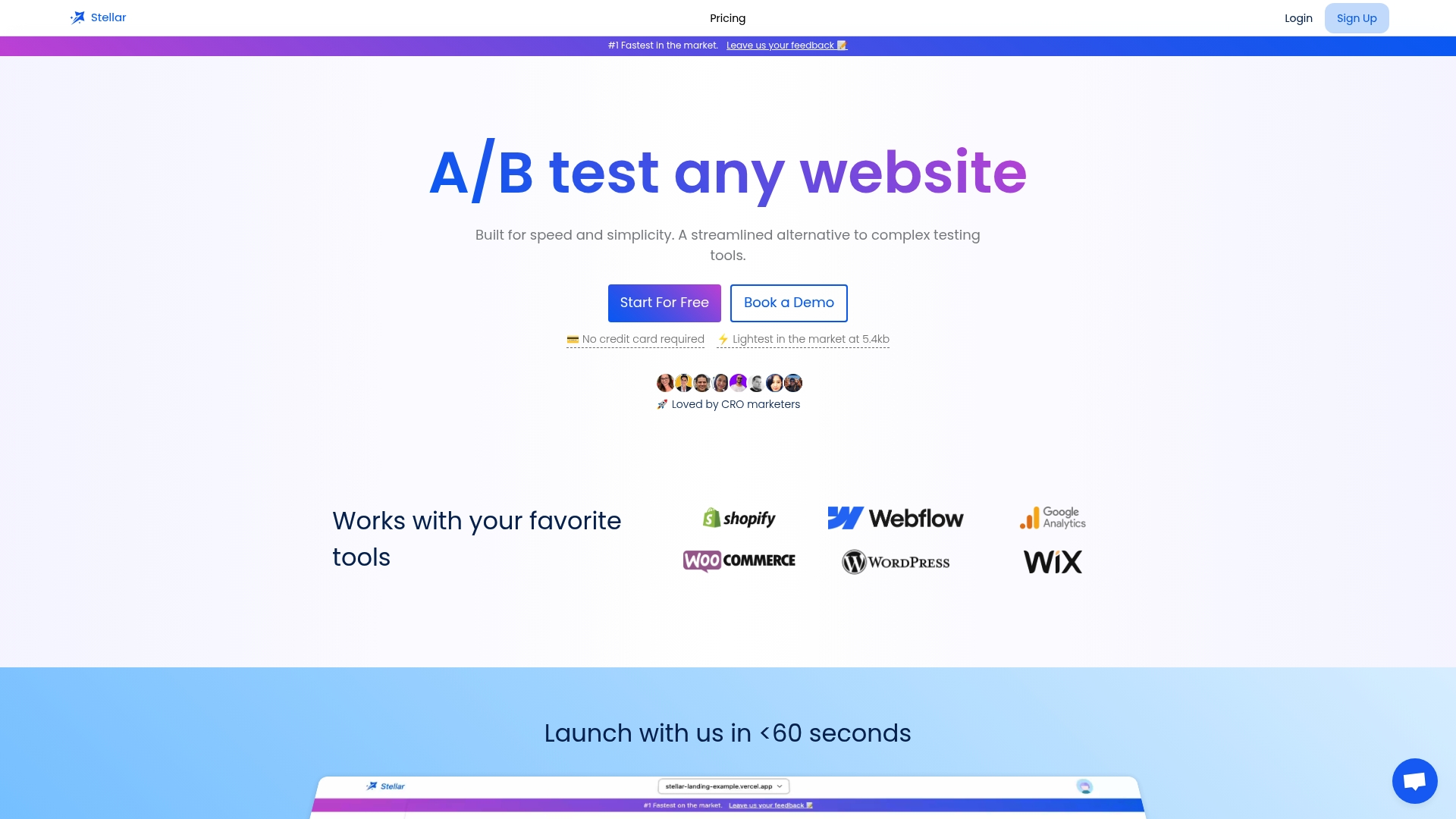
Ecommerce Navigation Optimization Guide for 2025 Success

Every click your customer makes on your website shapes their entire shopping experience. Here is the surprise. Research shows a 29.4 percent drop in information overload and a 7 percent jump in revenue just from smarter navigation menus. Most brands believe good navigation is a set-it-and-forget-it task. The real winners treat it as a living engine for growth.
Table of Contents
- Understanding Ecommerce Navigation User Behavior
- Best Practices For Ecommerce Navigation Optimization
- Practical Examples Of Optimized Navigation Menus
- Measuring And Improving Navigation Performance
Quick Summary
| Takeaway | Explanation |
|---|---|
| User Behavior Insights | Understanding user cognitive processing and behavioral patterns is crucial for optimizing navigation; effective navigation aligns with user expectations and minimizes cognitive load. |
| Optimized Structural Design | A logical and hierarchical navigation structure enhances user experience by allowing customers to find products quickly and intuitively. Consistent naming conventions and logical categorization are key factors. |
| Personalization Strategies | Implementing adaptive and intelligent navigation systems that use user behavior and preferences improves discoverability and enhances overall shopping experiences, driving higher conversion rates. |
| Technical Performance Matters | Navigation speed and responsiveness affect user engagement significantly; minimizing load times and ensuring mobile compatibility are essential components of effective navigation optimization. |
| Continuous Measurement and Improvement | Regularly monitoring key performance indicators such as bounce rates and user engagement metrics enables businesses to identify friction points and continuously refine their navigation strategies for better performance. |
Understanding Ecommerce Navigation User Behavior

Ecommerce navigation represents the digital roadmap guiding customers through online shopping experiences. Understanding user behavior within this navigational landscape becomes critical for businesses seeking to optimize conversion rates and enhance overall user engagement.
Cognitive Processing in Digital Navigation
Users interact with digital interfaces through complex cognitive processes that determine their browsing patterns and purchasing decisions. Research from the Electronic Commerce Research and Applications journal reveals that novel navigation designs can significantly impact consumer attention and arousal levels. When users encounter intuitive and well-structured navigation systems, their cognitive load decreases, allowing for smoother information processing and more streamlined decision making.
Key cognitive factors influencing navigation behavior include:
- Mental Model Alignment: Users develop mental models based on prior digital experiences. Navigation design that matches these preexisting expectations reduces friction and increases comfort.
- Visual Hierarchy: Clear visual cues and structured information presentation guide users naturally through product categories and purchasing pathways.
- Cognitive Efficiency: Minimizing unnecessary clicks and providing direct routes to desired information reduces mental effort.
Behavioral Patterns in Digital Wayfinding
Understanding user wayfinding behaviors requires deep insights into how individuals move through digital spaces. A comprehensive study utilizing transformer-based models demonstrated that analyzing multi-session clickstream data reveals intricate patterns of user engagement. These patterns highlight how navigation design directly influences user motivation, exploration, and ultimately, conversion potential.
Important behavioral observations include:
- Users typically scan web pages in predictable patterns, often following an F or Z shaped pattern
- First impressions of navigation clarity are formed within milliseconds
- Complex or cluttered navigation interfaces can lead to immediate user abandonment
Quantitative Insights into Navigation Performance
Research exploring consumer behavior on e-commerce platforms demonstrates that navigation effectiveness directly correlates with key performance metrics. Time spent reading product information, bounce rates, and exit rates provide tangible indicators of navigational success.
Metrics that matter include:
- Average time spent per category
- Number of clicks before purchase
- User path complexity
By comprehensively understanding these behavioral nuances, businesses can craft more effective conversion optimization strategies that transform user navigation from a potential obstacle into a seamless, engaging experience.
To help summarize user behavioral patterns and their impact on navigation, here is a table highlighting key cognitive and behavioral insights:
| Factor | Description | Impact on Navigation |
|---|---|---|
| Mental Model Alignment | Matches users' prior digital experiences | Reduces friction, increases comfort |
| Visual Hierarchy | Uses clear cues and structured info presentation | Guides users to desired locations |
| Cognitive Efficiency | Minimizes unnecessary clicks/directs to info quickly | Lowers mental effort |
| F/Z-Shaped Scanning Pattern | Common way users scan pages | Design should support easy scanning |
| First Impression Speed | Users form opinions within milliseconds | Navigation clarity is crucial |
| Information Complexity | Cluttered interfaces cause confusion | Leads to possible user abandonment |
Best Practices for Ecommerce Navigation Optimization

Effective ecommerce navigation optimization requires a strategic approach that balances user experience, technical performance, and conversion potential. Successful online stores transform navigation from a mere functional element into a powerful tool for guiding customer journeys and increasing sales.
Structural Design and Information Architecture
Research from industry experts highlights the critical importance of creating a clear and hierarchical navigation structure. The fundamental goal is to design an intuitive pathway that allows users to find products quickly and effortlessly. This involves developing a logical category hierarchy that reflects how customers think about products.
Key structural considerations include:
- Logical Categorization: Group products in ways that align with user expectations
- Depth and Breadth: Balance detailed subcategories with broad accessibility
- Consistent Naming Conventions: Use clear, descriptive labels that communicate product types instantly
Optimal navigation structures minimize cognitive load by presenting information in a predictable, easily digestible format. Users should be able to understand the site's organizational logic within seconds of landing on the page.
User-Centric Navigation Elements
Navigation goes beyond simple menu design. It encompasses a holistic approach to helping users find and engage with products. Legiit's optimization guidelines recommend implementing user-centric navigation elements that enhance discoverability and interaction.
Effective navigation elements include:
- Prominent search functionality with autocomplete suggestions
- Clear filtering and sorting options
- Breadcrumb trails that show users their current location
- Recommended and related product sections
- Mobile-responsive design that adapts to different screen sizes
The goal is to create a seamless experience that anticipates user needs and reduces friction in the shopping process. Each navigation element should serve a specific purpose in guiding users towards conversion.
Technical Optimization and Performance
Navigation optimization extends beyond visual design into technical implementation. Performance studies demonstrate that navigation speed and responsiveness directly impact user engagement and conversion rates.
Critical technical considerations include:
- Minimal page load times
- Responsive design across devices
- SEO-friendly URL structures
- Semantic HTML markup for improved accessibility
- Clean, efficient code that supports quick rendering
Businesses can enhance their conversion strategies by treating navigation as a dynamic, data-driven component of their online presence. Continuous testing, user feedback analysis, and iterative improvements are essential for maintaining an effective navigation system that evolves with changing user expectations.
Practical Examples of Optimized Navigation Menus
Navigation menus represent the critical interface between users and online product offerings. Effective menu design transforms complex product ecosystems into intuitive, user-friendly experiences that guide customers seamlessly through purchasing journeys.
Hierarchical Category Structuring
Research from the Journal of Product and Market Engineering demonstrates that strategic category organization is fundamental to user engagement. Top-performing e-commerce platforms like Amazon exemplify advanced hierarchical navigation techniques that balance comprehensive product coverage with intuitive browsing.
Key principles of hierarchical menu design include:
- Top Level Clarity: Primary categories should be broad yet distinct
- Logical Subcategory Progression: Create natural drill-down paths
- Balanced Information Density: Prevent overwhelming users with excessive options
For instance, a well-structured electronics category might start with broad segments like "Computers" and "Smartphones" before offering nuanced subcategories such as "Gaming Laptops" or "Professional Workstations" that provide targeted navigation pathways.
Mega Menu Optimization Strategies
The Baymard Institute's comprehensive research reveals that mega menus can significantly enhance user navigation when implemented strategically. Effective mega menus go beyond simple dropdown lists by offering visual previews, product thumbnails, and contextual recommendations.
Advanced mega menu techniques include:
- Dynamic content placement
- Visual product categorization
- Contextual recommendation panels
- Quick access search integration
- Mobile-responsive design adaptations
Successful implementations balance information richness with clean, uncluttered design. The goal is to provide comprehensive navigation options without overwhelming the user's cognitive processing capabilities.
Personalization and Adaptive Navigation
Modern navigation menus transcend static structures by incorporating intelligent personalization mechanisms. By analyzing user behavior, purchase history, and browsing patterns, e-commerce platforms can dynamically adjust navigation experiences.
Personalization strategies encompass:
- Customized category recommendations
- Recently viewed product highlighting
- Contextual menu reorganization
- Machine learning driven navigation optimization
Businesses can explore advanced conversion optimization techniques to refine these personalization approaches. The future of navigation design lies in creating adaptive, intelligent systems that anticipate and respond to individual user preferences in real time.
By implementing these sophisticated navigation strategies, e-commerce platforms can transform menu design from a functional necessity into a powerful tool for enhancing user experience and driving conversion rates.
Here’s a table that summarizes different navigation menu strategies discussed, along with their core features and benefits:
| Navigation Strategy | Features | Benefits |
|---|---|---|
| Hierarchical Structuring | Top-level/broad categories, drill-down paths | Quick product discovery, user clarity |
| Mega Menus | Visual previews, dynamic content, recommendations | Rich navigation, reduced friction |
| Personalization/Adaptive | User-driven categories, behavior-based | Higher engagement, relevant experiences |
Measuring and Improving Navigation Performance
Navigating the complex landscape of e-commerce performance requires a comprehensive approach to measuring and enhancing user interaction metrics. Successful businesses recognize that navigation performance extends far beyond simple click-through rates and demands a nuanced, data-driven strategy.
Key Performance Indicators for Navigation
Research exploring e-commerce website performance reveals three critical dimensions for evaluating navigation effectiveness: usage metrics, financial benefits, and overall user satisfaction. Understanding these interconnected factors provides a holistic view of navigation performance.
Critical navigation performance indicators include:
- User Engagement Metrics: Time spent per category, bounce rates, click depth
- Conversion Tracking: Percentage of users completing desired actions
- Search Efficiency: Average number of clicks to find a product
- User Satisfaction Scores: Direct feedback and usability ratings
These metrics offer insights into how effectively users navigate through product ecosystems, identifying potential friction points and optimization opportunities.
Advanced Recommendation and Personalization Strategies
An analysis of e-grocery recommender systems demonstrated remarkable improvements through personalized navigation approaches. By implementing sophisticated recommendation algorithms, businesses can significantly enhance user experience and drive tangible business outcomes.
Key personalization techniques include:
- Long-tail ranking algorithms
- Context-aware recommendation systems
- Dynamic content personalization
- Predictive user journey mapping
The research highlighted substantial benefits:
- 29.4% reduction in information overload
- 3.3 seconds decreased search time per item
- 7% increase in potential revenue
To present the measurable benefits of navigation optimization strategies discussed, here's a summary table of key statistical outcomes:
| Optimization Outcome | Benefit Achieved |
|---|---|
| Reduction in Information Overload | 29.4% |
| Decreased Search Time Per Item | 3.3 seconds |
| Increase in Potential Revenue | 7% |
Performance Optimization and Continuous Improvement
A study on preference-based search interfaces underscores the importance of adaptive navigation systems. Users consistently report higher satisfaction when presented with alternatives that closely match their preferences.
Optimization strategies encompass:
- Regular user experience audits
- A/B testing of navigation elements
- Machine learning driven personalization
- Continuous feedback loop integration
Businesses can accelerate their performance testing approach by adopting a systematic, data-driven methodology. The goal is to create a dynamic navigation ecosystem that evolves in real time, anticipating and meeting user needs with unprecedented precision.
By embracing these advanced measurement and optimization techniques, e-commerce platforms can transform navigation from a functional necessity into a strategic competitive advantage that drives user engagement and business growth.
Frequently Asked Questions
What is ecommerce navigation optimization?
Ecommerce navigation optimization involves restructuring and enhancing the navigation menus on online stores to improve user experience, making it easier for customers to find products and complete purchases.
Why is user behavior important in ecommerce navigation?
Understanding user behavior is critical because it informs how customers interact with navigation menus. Insight into cognitive processing and behavioral patterns helps businesses create intuitive navigation that aligns with user expectations and minimizes confusion.
What are some best practices for optimizing ecommerce navigation?
Best practices include creating a clear and hierarchical category structure, implementing user-centric navigation elements (like search functionality and filters), and ensuring technical performance with fast load times and mobile responsiveness.
How can I measure the effectiveness of my ecommerce navigation?
To measure navigation effectiveness, track key performance indicators such as user engagement metrics (time spent per category, click depth), conversion rates, and user satisfaction scores to identify friction points and opportunities for improvement.
Turn Navigation Insights Into Conversions With Stellar
Struggling to translate navigation best practices into real business growth? You are not alone. The article exposes how information overload, slow navigation, and confusing menus sap user attention and waste your revenue potential. But optimizing your ecommerce navigation requires more than research or guesswork. You need proof-driven strategies and agile technology to test, refine, and launch the perfect user experience—fast.

Ready to act on what you learned above? Start A/B testing smarter navigation changes in minutes with Stellar. Our no-code visual editor lets you create variations instantly. With Stellar’s lightweight script and real-time analytics, you can spot navigation bottlenecks and turn them into conversion wins. Do not let hesitation keep your revenue flat. Visit https://gostellar.app today and see how simple growth experiments can transform your online store before competitors catch up.
Recommended
- Ecommerce Conversion Rate Optimization Strategies for 2025
- Optimiser la performance site e-commerce : stratégies clés 2025
- Proven Strategies to Increase Conversion Rate E-Commerce and Boost Your Online Sales
- E-Commerce Conversion-Optimierung 2025: Strategien für mehr Umsatz
- Optimiser son taux de conversion e-commerce : les stratégies gagnantes pour 2025
- Ecommerce Conversie Optimaliseren: Onmisbare Strategieën voor 2025
Published: 7/13/2025